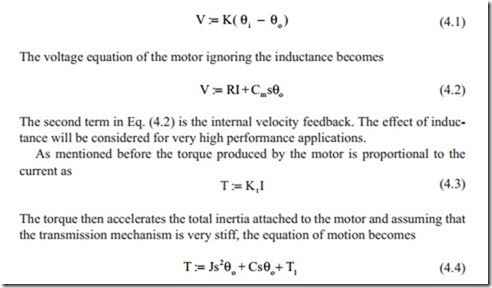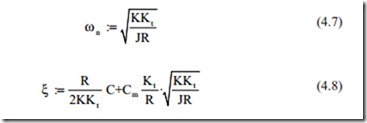DC Servo Motors in Closed Loop Position Control
First, a proportional control in which the command signal with the output position is compared and the difference is multiplied by a gain is considered. The equation for the control unit is
The external torque is positive because it usually opposes the motion.
For complicated systems, it is often easier to derive the governing transfer function directly from the governing differential equations and it is not necessary to draw the block diagram of the system. The readers are encouraged to drive the overall transfer function with both methods.
Eliminating V, I, and T from Eqs. (4.1– 4.4) and with some complicated algebraic manipulation, the transfer function of the systems becomes
It can be seen that there are two inputs variables of θi,Tl and one output variable. The principle of superposition may be used to study the effect of both input variables. When the external torque is set to zero and at steady state for step input of θi, the Laplace Transform s may be set to zero. This shows that the output is exactly the same as input meaning that the steady state error is zero. For a ramp input, the er- ror must be calculated and it can be shown that there will be a following error. The reader is encouraged to calculate the following error with procedures discussed in previous chapters.
When the external torque is applied, a steady state is generated and steady state error is given by
The dynamic behavior for both input variable and external torque is determined by the common characteristic equation, which in this case is a second order. The properties of this kind of characteristic equation is determined by natural frequency and damping ratio given by
It can be seen as the gain K is increased, the steady state error reduces and the natu- ral frequency increases. This is desirable but Eq. (4.8) shows that as K increases, the damping ratio reduces. A compromise has to be made between these two conflicting requirements. All other parameters are given by the manufacturer of DC servo mo- tors and the design parameters of the system.
The reader is encouraged to obtain a catalogue from the manufacturer to study the system behavior numerically. The friction of the mechanical part if the load is attached to the motor directly may be set to zero otherwise a value must be obtained experimentally.
If an integrator in addition to the proportional control is added, the characteristic equation becomes third order. The system may become unstable and careful analy- sis must be carried out. The gains of the proportional controller and the integrator must be evaluated so the system remains stable with sufficient damping for the complex roots. The following error and the effect of external torque in this case becomes zero.
For position control applications, a position feedback must be used. If the motor is attached to a rotary mechanism, a variable potentiometer or a position encoder may be used. The position encoder is a device that generates a pulse for each unit of angular position of the motor. This may be as small as a fraction of rotational degrees. If the motor is connected to a load through a lead screw, a linear variable potentiometer may be used. For both rotary and linear motion, an encoder may be attached to the motor and calibrated according the angular position of the mo- tor. Some electronic devices usually are used to convert the difference between the demand position and the output position to a control signal, which determines the required torque output of the motor.
In designing servo position control system with DC servo motors, the motor must be matched to the load. The motors are available in different speeds and output torque. A gearbox is usually used to reduce the speed of motor to required linear or rotary motion. The torque applied to the motor must be calculated and the motor
must be able to generate this torque. The other parameter of interest is the inertia referred to the motor. The large inertia with small motor may generate very slow response and large steady states error. Several motors must be considered and the best motor must be selected. The rule of thumb is that the inertia of rotor of the motor must be at the same rating as the inertia referred to the motor.




